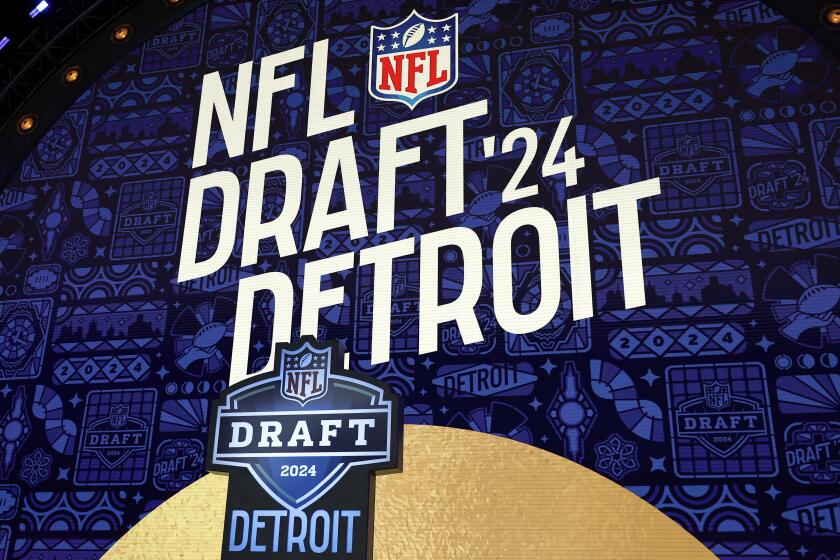For 2009 British Open, Tiger Woods works on his Turnberry twists
They’re talking about rough here so lush and dense and nefarious that players could lose golf balls or even golf bags or maybe even the occasional caddie.
They’re talking about bunkers, a rash of new fairway bunkers, bunkers that sometimes appear lunar in depth and as if equipped with large invisible vacuum cleaners.
Mostly, though, the contestants at the 138th British Open have been talking about tee shots, as if Turnberry’s first Open since 1994 will hinge even more than usual on what happens at tee boxes fraught with peril, a worry having nothing to do with the cliff-top tees where a mean gust might blow somebody into the Firth of Clyde.
Two-time defending champion Padraig Harrington said it “definitely suits somebody who’s going to drive very well.” The 2008 runner-up Ian Poulter called it “a very difficult golf course from the tee.” The highest-ranked player on hand other than Tiger Woods -- No. 3 Paul Casey -- called it “a tee-shot golf course.” And the player right behind Casey at No. 4, Kenny Perry, implored, “You’ve got to hit a lot of fairways this week.”
For Woods to tack a fourth win onto a year he already calls “a tremendous success” even without a major title yet, for him to log a 15th major title and receive a congratulatory text from his Swiss chum and 15-major-winner Roger Federer, for him to win a fourth Claret Jug and burnish Turnberry’s knack for rewarding golf’s brightest lights, he’ll probably have to sustain what began at Jack Nicklaus’ tournament in Ohio, the one where Nicklaus kidded Woods about his sudden tee-shot accuracy.
When Woods arrived at Royal Liverpool in 2006, he ranked 139th in driving accuracy, scrutinized the course and hatched the imaginative strategy of trying to win without his driver. Using it only once all week, he relied on clubs like his two-iron and shot merely 18 under par to win the thing.
When Woods arrived at Nicklaus’ Memorial tournament in early June, his driving accuracy in four stroke-play tournaments in 2009 had been 60.7%, 60.7%, 64.3% and 44.6%. That he’d finished T-9, 1, T-6 and 4 in those events would seem another clue that he might just be unusually adept at golf.
Well, that week, while letting the driver come out to play with the others, he hit 87.5% of the fairways, including the majestic 100% -- 14 for 14 -- on the closing Sunday as he reported harrowingly, “My practice sessions started getting longer at home. . . . I can practice like I used to.”
Asked for his previous such display, he said, “Hoylake. I did all right there.”
From the Memorial, he rang in 67.9% of his tee shots at the U.S. Open (tied for sixth) and 73.2% at the AT&T; National (won that too), with his length re-lengthening as he went along and his rebuilt knee offering no problem.
Now, he eyeballs a major course whose three British Open winners are Tom Watson in 1977, Greg Norman in 1986 and Nick Price in 1994, three best-on-earth-at-that-time sorts, with an intensely honorable mention to Jack Nicklaus, who finished one behind Watson but 10 ahead of everyone else in 1977.
“I think you look at the guys who were some of the best ball-strikers,” Woods said, “and at this golf course you can understand why. . . . You’ve got to hit some really good shots and you’ve got to understand why the last three champions are some of the best ball-strikers. You have to do that here.”
And while Norman shot one of the sport’s greatest rounds -- a second-round 63 in appalling weather -- the need for accuracy aches ever more with the rain-fed rough of 2009 plus the latest 21st-century course-toughening tricks.
Even the fearsome and pig-headed gorse, while often well beyond the first areas of rough, appears especially green and predatory. A recent tournament of 150 members featured 480 lost balls, Colin Montgomerie reported last week at the Scottish Open while adding, “So there’s 480 golf balls lying around there somewhere,” and, “If you do miss the fairway, my goodness me.”
Graeme McDowell said of No. 17, “I’ve never seen rough as thick in all my life.” Harrington: “Nature is taking its course.” Perry: “To me it seems like you’re penalized more for your off-line shots here.”
And Angel Cabrera, the reigning Masters champion, has surveyed the bunkers and declared, “I think I’m going to be playing short of the bunkers pretty much all week. That will be my strategy.” Across the country at the rigorous Carnoustie, he said, “You can attack a few holes” and “hit the driver off the tee more often. Here, you have to be cautious all the time.”
“You just can’t fake it around this golf course,” Woods concluded, and while he has never had to fake it, the evidence shows that he definitely and brilliantly has finagled it. Only of late, he hasn’t even had to do that.
--
--
British Open
Thursday-Sunday
at Turnberry, Scotland Ailsa Course
More to Read
Get our high school sports newsletter
Prep Rally is devoted to the SoCal high school sports experience, bringing you scores, stories and a behind-the-scenes look at what makes prep sports so popular.
You may occasionally receive promotional content from the Los Angeles Times.






